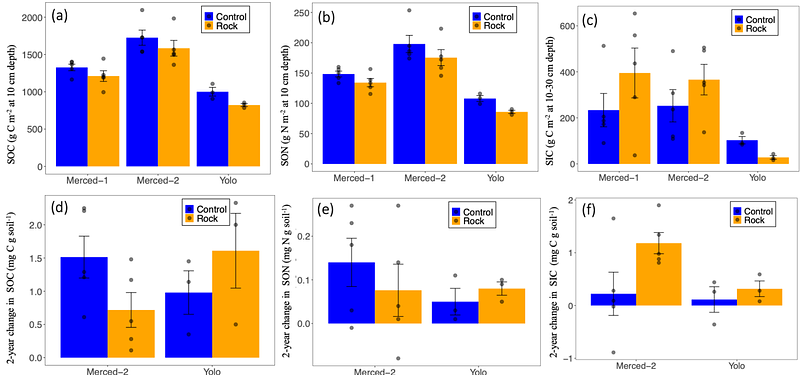Reduced accrual of mineral-associated organic matter after two years of enhanced rock weathering in cropland soils, though no net losses of soil organic carbon

Reduced accrual of mineral-associated organic matter after two years of enhanced rock weathering in cropland soils, though no net losses of soil organic carbon
Sokol, N. W.; Sohng, J.; Moreland, K.; Slessarev, E.; Goertzen, H.; Schmidt, R.; Samaddar, S.; Holzer, I.; Almaraz, M.; Geoghegan, E.; Houlton, B.; Montanez, I.; Pett-Ridge, J.; Scow, K.
AbstractEnhanced rock weathering (ERW), the application of crushed silicate rock to soil, can remove atmospheric carbon dioxide by converting it to (bi)carbonate ions or solid carbonate minerals. However, few field studies have empirically evaluated ERW in field settings. A critical question remains as to whether additions of crushed rock might positively or negatively affect soil organic matter (SOM), the largest terrestrial organic carbon (C) pool and a massive reservoir of organic nitrogen (N) on Earth. Here, in three irrigated cropland sites in California, USA, we investigated the effect of crushed meta-basalt rock additions on different pools of soil organic carbon and nitrogen (i.e., mineral-associated organic matter and particulate organic matter), active microbial biomass, and microbial community composition. After two years of crushed rock additions, mineral-associated organic matter (MAOM) stocks were lower in the upper surface soil (0-10 cm) compared to unamended controls. At the two sites where baseline pre-treatment data were available, neither total SOC nor SON decreased over the two years of study in crushed rock or unamended control plots. However, the accrual rate of MAOM-C and MAOM-N at 0-10 cm was lower in plots with crushed rock vs. unamended controls. Before ERW is deployed at large scales, our results suggest that field trials should assess the effects of crushed rock on SOM pools, especially over multi-year time scales, to accurately assess changes in net C and understand the mechanisms driving interactions between ERW and SOM cycling.


